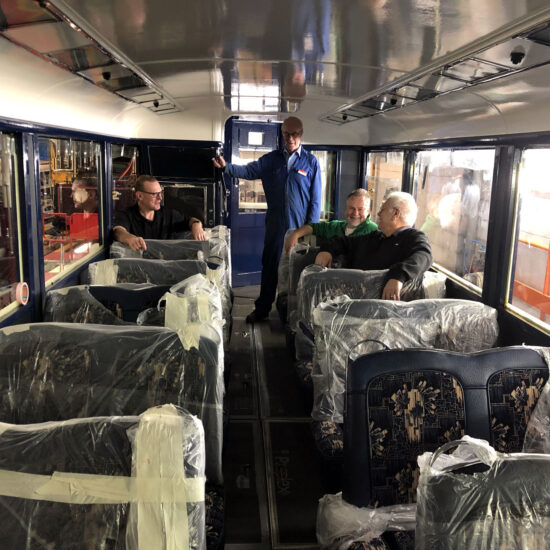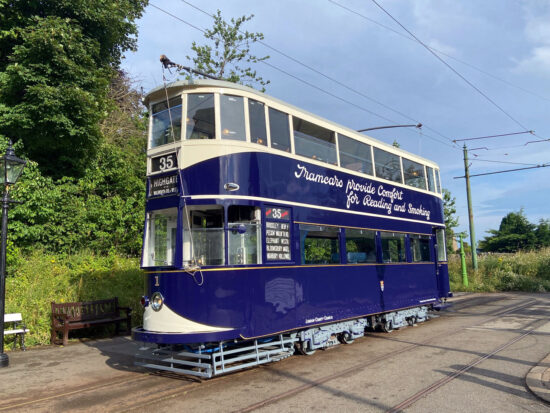As the 10 year restoration project comes to an end it has been confirmed that London County Council 1 – more commonly known as Bluebird – will be launched in an event for special guests and Tramway Museum Society (TMS) members at the Crich Tramway Village on Friday 13th September 2024. All being well it is then likely that Bluebird will run in public service for the first time since 1957 over the Electric 60 Tram Weekend on Saturday 14th and Sunday 15th September.
1 was initially launched on 5th May 1932 and was planned as an experimental tramcar which would help to modernise the image of trams in London. It officially entered service on 10th June 1932 and press reviews called it a “tramcar revolution” and spoke of “Rolls-Royce” levels of passenger comfort. Receiving a striking royal blue and ivory livery it acquired the nickname of “Bluebird” – the livery also helped to accentuate its streamlined appearance and allowed it to really stand out from the rest of the LCC tram fleet.
Sadly soon after all trams within the capital came under the auspices of the newly created London Passenger Transport Board (LPTB) and within five years it lost the blue and went red whilst the days of trams were limited as a policy of tram abandonment was introduced.
Salvation for 1 came though in the form of Leeds Corporation Tramways who purchased the tram (along with many Felthams) in June 1951 for the cost of £500 plus £300 in transport costs. It was renumbered 301 in West Yorkshire and entered service on 1st December 1951. The fact that it made it to Leeds though is a quirk of fate as it only went north in lieu of Felthams which were damaged by fire – if this had not happened there is a chance that this article would not have even been started as it is likely to have been scrapped in the 1950s!
301’s days in Leeds ended in 1957 which is when it entered preservation. Moving back home to London in 1959 it was moved from Charlton Works to Clapham and in 1963 was moved to the large exhibits section of the Museum of British Transport in Clapham.
December 1972 saw the tram move to Crich having been donated to the Tramway Museum Society and it became a static exhibit there, receiving a repaint in March 1978 with further attention seeing the tram returned more towards the condition it had when running in London.
The next 35 years were a fairly quiet period for the tram with it remaining a static exhibit but the London County Council Tramways Trust (LCCTT) approached Crich with a view to restoring the tram to operational condition and raised funds through their membership to allow work to proceed. Saturday 14th June 2014 saw restoration start when it was moved into the Workshop.
Extensive work then took place over the next eight years and in April 2022 it moved under its own power for the first time not only at Crich but also since it was withdrawn from service in 1957. More work has followed and we have now reached the stage where the tram is almost ready to enter service.
Ian Ross, Chairman of the LCCTT, member of the TMS and volunteer in the Workshop, said: “This tram was first launched in 1932 and was designed to give passengers and tram crews a higher level of comfort, similar to the buses of the time. Bluebird was destined to be a solitary example of what might have been in London’s transport system.
“During the project, the engineers at the Museum have dealt with many challenges with patience and ingenuity. The project has been ably assisted by the members of the London County Council Tramways Trust. The Trust has also funded the full cost of the restoration.
“As a personal comment, I’m always impressed by the skills of the museum team and the result of their efforts.”
The restoration of the tram links firmly to the Tramway Museum’s core purposes to “share, inspire and educate through telling the story of tramways”.
Kate Watts, Crich Tramway Village Curator, said: “After ten years of hard work by our Conservation Workshop team, we’re thrilled to celebrate the return of this magnificent Art Deco tramcar. We hope that our visitors will enjoy riding on ‘Bluebird’ for many years to come.”
Karen Rigg, Tramway Museum Society Chairman, added: “We are absolutely thrilled that Bluebird is now ready for launch. Having watched the process from the beginning, when the tramcar became a pile of sundry components and parts to the point where we have this beautiful vehicle has been fascinating. Testament goes to all the members of the team in our conservation workshop whose skills have made this possible, and to the LCCTT for raising the funds to make it happen.”
- You can read the full story about the origins, operation and restoration of no. 1 in the excellent book Bluebird Reborn which is available from the Crich Tramway Village’s shop.




